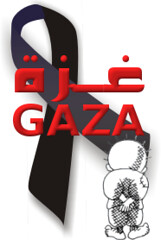Remembering Jenin
p
 'Jenin: Such ordinary homes. Such ordinary people..' (Reuters/file)
'Jenin: Such ordinary homes. Such ordinary people..' (Reuters/file) By Stephen Williams
The Martyrs' Cemetery is but a few meters from Jenin Refugee Camp. On a warm, sunny day I stood in front of the memorial to the victims of the massacre of 2002 and remembered them, as I had long promised to do. I remembered the forgotten.
It is not an imposing monument; had the victims been Israeli, a more grandiose memorial would have been built, perhaps with a museum, perhaps with a carefully-maintained eternal flame. I was disappointed at first. Is this what I had travelled from Occupied Jerusalem to see? Through Ramallah, Nablus and those checkpoints manned by bored, surly adolescent soldiers?
But then I understood; the victims were ordinary people- men, women and children- trying to live ordinary lives, until they came face to face with an extraordinary interruption; the appearance of the highly-mechanised, US- resourced Israel Defence Force at their very their doorsteps. Most of them died in or just outside their homes. Such ordinary homes. Such ordinary people. No huge, imposing monument for them.
The story of the invasion, the heroic resistance and the demolition of Jenin Camp is related in Ramzy Baroud’s "Searching Jenin". The author had written a message to me, “Remember Jenin”, inside the cover of my copy and I was here; to remember.
It had begun on 3 April 2002 with an artillery barrage. The next day, access was blocked; there was no escape for the residents. Apaches, Cobras and tanks did their work. And bulldozers. One of the drivers, known as Kurdi Bear, enjoyed his fifteen minutes of celebrity as he recounted the relish with which he had destroyed the homes of the residents.
“If I’d been given three weeks, I would have had more fun,” he said. As it happens he had only ten days to complete his grisly work while the world’s population watched, some uncaring, some impotently angry, some with smug satisfaction, from outside.
Ramzy Baroud records the names of over sixty shahid, though it is likely that there were many more. The IDF had been able to work in total secrecy during the period the camp was sealed. The camera crews waited beyond the road blocks until it was done.
In retrospect, the attack on Jenin appears to be a ghastly dress-rehearsal for Gaza, the closure, the refusal to allow media access, the executions, the demolitions; and the excuses and the denials. Jenin was “a nest of vipers”, Gaza a “hotbed of fundamentalism”. The IDF is the most moral army in the world.
And just as the UN was coerced by Israel and the US into abandoning an enquiry into Jenin, it would be unwise to expect a different response to Gaza. The victims of the Gaza are no less ordinary than those of Jenin.
But one aspect is different; there is hardly any photographic evidence of what happened during the Jenin assault; we have only moving testimonies and photographs of the aftermath. In Gaza, on the other hand and much to the unconcealed fury of the Israeli government and its apologists, footage was broadcast, some of it live. The media ban had failed. 21st century technology had played a unique role in an old conflict. And any activist here in the UK will tell you what a devastating effect this has had on public opinion.
Exploring with my Palestinian friend the refugee camp, I confirmed that the houses had been re-built by the UN. He said they were better, much better, than what had been there before. But Jenin Refugee Camp is still a refugee camp. The streets are narrow, the houses small, the facilities for the children, well over half of the population, depressingly limited.
And they are still refugees. Their homes are across the border. Their fathers’ bones call for them.
I remembered another, surprising, victim; my fellow-Briton Ian Hook, a UN engineer employed in the rebuilding. He was shot dead by the Israelis during the reconstruction; his mobile phone, apparently, looked like a gun.
As in all Palestinian refugee camps, the shahid are revered; their posters adorn the shabby streets. I was observing one of them, of two young men in the familiar military pose, when an old man called and invited us into his home.
The two boys were his sons, assassinated by the IDF years after the invasion. Jenin’s agony, Palestine’s agony, did not end with the demolition of the camp, nor did resistance. As he told the story, I couldn’t find the words to console him and so I put my arms around him. He was moved and kissed me.
As I left, I turned to look at him at his door and put my hand on my heart.” I shall remember,” I said in a language he did not understand. He returned the gesture.
Back at the Martyrs’ Graveyard, I stood again in front of that little memorial, so mean and yet now so splendid. I remembered the shahid of Jenin; thirteen year old Mohammed Omar Hawashin, killed by a sniper; sixty-five year old Muhammed Masoud Abu al- Sibah, crushed to death when an Israeli bulldozer destroyed his home while he was still in it; Miriam Abdullah Wishahe, a fifty-two year old woman who also killed by a sniper. And many, many more. I remembered the shebab who held the mightiest army in the region at bay for all those terrible, long bloody days, matching their AK47s against Apaches.
And I said a Christian prayer for the souls of the shahid.
- Stephen Williams is based in the UK. He contributed this article to PalestineChroniclee.com.












